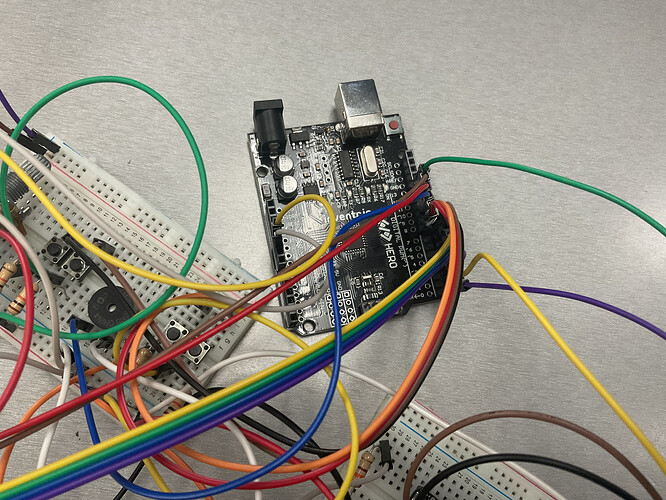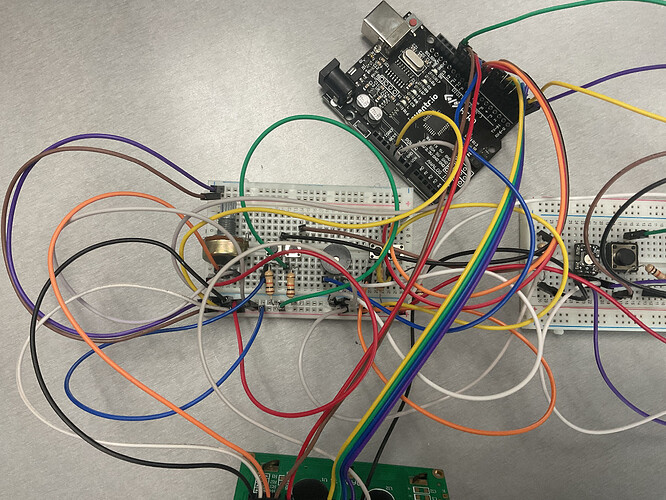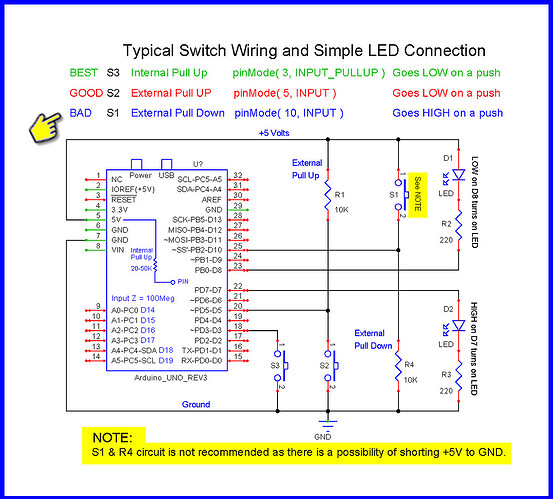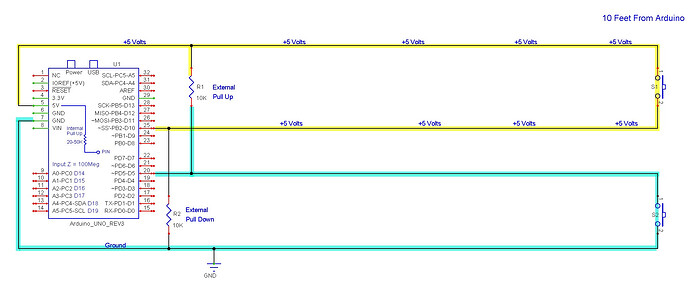me and my friend are first year beginners, and we are trying to do a circuit from Tinkercad, (ping pong) and our LCD is not showing the setup and the functions. The rest of our physical circut functions correctly. We would appreciate your help.
*We did not write the code
also ask if you need better pics
/*
*/
// include the LiquidCrystal library
#include <LiquidCrystal.h>
LiquidCrystal lcd(12, 11, 5, 4, 3, 2);
// include the Adafruit_NeoPixel library
#include <Adafruit_NeoPixel.h>
// LED for player 1
#define neoPixel1 0
// LED for player 2
#define neoPixel2 1
#define LEDs 1
//create a NeoPixel strip1
Adafruit_NeoPixel strip1 = Adafruit_NeoPixel(LEDs, neoPixel1, NEO_GRB + NEO_KHZ800);
//create a NeoPixel strip2
Adafruit_NeoPixel strip2 = Adafruit_NeoPixel(LEDs, neoPixel2, NEO_GRB + NEO_KHZ800);
//Start, pause button
#define start 13
// Player1 up push button pin
#define P1U 6
// Player1 down push button pin
#define P1D 7
// Player2 up push button pin
#define P2U 8
// Player2 down push button pin
#define P2D 9
// piezo electric crystal pin
#define piezo 10
//paddle1
byte paddle1[16] = {0, 0, 0, 0, 0, 0, 1, 1, 1, 1, 0, 0, 0, 0, 0, 0}; // array to hold paddle1 LCD row-0&1 values
byte player11[8] = {0, 0, 0, 0, 0, 0, 1, 1}; // array to hold paddle1 LCD row-0 values
byte player12[8] = {1, 1, 0, 0, 0, 0, 0, 0}; // array to hold paddle1 LCD row-1 values
//paddle2
byte paddle2[16] = {0, 0, 0, 0, 0, 0, 16, 16, 16, 16, 0, 0, 0, 0, 0, 0};// array to hold paddle2 LCD row-0&1 values
byte player21[8] = {0, 0, 0, 0, 0, 0, 16, 16}; // array to hold paddle2 LCD row-0 values
byte player22[8] = {16, 16, 0, 0, 0, 0, 0, 0}; // array to hold paddle2 LCD row-1 values
//ball
byte ball[16] = {0, 0, 0, 0, 0, 0, 0, 1, 0, 0, 0, 0, 0, 0, 0, 0}; // array to hold ball LCD row-0&1 values
byte ball1[8] = {0, 0, 0, 0, 0, 0, 0, 1}; // array to hold ball LCD row-0 values
byte ball2[8] = {0, 0, 0, 0, 0, 0, 0, 0}; // array to hold ball LCD row-1 values
/*
x - cursor for ball
bounce - status of bounce (0 - ball moves down, 1 - ball moves up)
direction - direction of ball (L - left, R - right)
v1, v2 & v3 - variables used to check whether the ball hits the paddles or not
score1 - score of player1
score2 - score of player2
game - start/stop (0 - stop, 1 - start)
*/
int x = 0, bounce = 0, v1 = 0, v2 = 0, v3 = 0;
char direction = 'L';
int score1 = 0, score2 = 0;
boolean game = 0;
int a = 0;
/*----------------------------------------setup function--------------------------------*/
void setup() {
// initiate Neo_pixel LEDs
strip1.begin();
strip1.show();
strip2.begin();
strip2.show();
pinMode(P1U, INPUT); // setting push buttons as inputs
pinMode(P1D, INPUT);
pinMode(P2U, INPUT);
pinMode(P2D, INPUT);
pinMode(start, INPUT);
pinMode(piezo, OUTPUT); // setting piezo electric crystal as outputs
piezoSound(50); // piezo makes sound for 50 ms
lcd.begin(16, 2); // begin lcd communication
lcd.clear(); // clear lcd screen
lcd.setCursor(2, 0); // set LCD cursor to (2, 0)
lcd.print("Arduino UNO"); // print data on LCD display
lcd.setCursor(1, 1);
lcd.print("Ping Pong Game");
delay(1500);
lcd.clear();
lcd.setCursor(0, 0);
lcd.print("Developed by:");
lcd.setCursor(0, 1);
lcd.print("AIAP");
delay(3000);
}
/*----------------------------------------end of setup function--------------------------------*/
/*----------------------------------------loop function---------------------------------------*/
void loop() {
//executes this while loop untill start button is pressed
while (game == 0) {
for (a; a < 1; a++) {
for (int i = 0; i < 16; i++) {
if (6 <= i && i <= 9) {
paddle1[i] = 1;
paddle2[i] = 16;
}
else {
paddle1[i] = 0;
paddle2[i] = 0;
}
if (i == 7)ball[i] = 1;
else ball[i] = 0;
}
x = 8; // set ball cursor to 8
lcd.clear();
lcd.setCursor(3, 0);
lcd.print("Press start");
lcd.setCursor(3, 1);
lcd.print("button ->");
}
// check whether the start button is pressed
if (digitalRead(start) == HIGH) {
lcd.clear();
lcd.setCursor(5, 0);
lcd.print("Player");
lcd.setCursor(0, 1);
lcd.print("1");
lcd.setCursor(15, 1);
lcd.print("2");
delay(2000);
for (int i = 3; i > 0; i--) {
lcd.clear();
lcd.setCursor(4, 0);
lcd.print("Be ready!");
lcd.setCursor(8, 1);
lcd.print(i);
if (i == 1)piezoSound(100);
delay(1000);
}
a = 0;
game = 1; // set game to 1, exits the while loop and starts the game
}
delay(100);
}
// game starts
//when P1U is pressed, the paddle1 moves up
if (digitalRead(P1U) == HIGH) {
paddle1Up();
delay(50);
}
//when P1D is pressed, the paddle1 moves down
if (digitalRead(P1D) == HIGH) {
paddle1Down();
delay(50);
}
//when P2U is pressed, the paddle2 moves up
if (digitalRead(P2U) == HIGH) {
paddle2Up();
delay(50);
}
//when P2D is pressed, the paddle2 moves down
if (digitalRead(P2D) == HIGH) {
paddle2Down();
delay(50);
}
//split paddle1 array into 2 arrays, paddle11 and paddle12
for (int i = 0; i <= 7; i++) {
player11[i] = paddle1[i];
}
for (int i = 0, j = 8; i <= 7, j <= 15; i++, j++) {
player12[i] = paddle1[j];
}
//split paddle2 array into 2 arrays, paddle21 and paddle22
for (int i = 0; i <= 7; i++) {
player21[i] = paddle2[i];
}
for (int i = 0, j = 8; i <= 7, j <= 15; i++, j++) {
player22[i] = paddle2[j];
}
//split ball array into 2 arrays, ball11 and ball12
for (int i = 0; i <= 7; i++) {
ball1[i] = ball[i];
}
for (int i = 0, j = 8; i <= 7, j <= 15; i++, j++) {
ball2[i] = ball[j];
}
//create custom shapes for paddle1, paddle2 and ball
lcd.createChar(0, player11);
lcd.createChar(1, player12);
lcd.createChar(2, player21);
lcd.createChar(3, player22);
lcd.createChar(4, ball1);
lcd.createChar(5, ball2);
//print paddle1, paddle2 and ball
lcd.clear();
lcd.setCursor(0, 0); // position of score1
lcd.print(score1);
lcd.setCursor(0, 1); // position of score2
lcd.print(score2);
lcd.setCursor(3, 0); // position of player11
lcd.write(byte(0));
lcd.setCursor(3, 1); // position of player12
lcd.write(byte(1));
lcd.setCursor(15, 0); // position of player21
lcd.write(byte(2));
lcd.setCursor(15, 1); // position of player22
lcd.write(byte(3));
lcd.setCursor(x, 0); // position of ball1, x is changed to move the ball on the display
lcd.write(byte(4));
lcd.setCursor(x, 1); // position of ball2, x is changed to move the ball on the display
lcd.write(byte(5));
// checks whether the ball hits the paddle1
if (x == 3) {
for (int b = 0; b < 16; b++) {
if (ball[b] != 0) {
v1 = ball[b];
v2 = paddle1[b];
}
}
// if ball hits paddle1, change direction of ball to R (right)
if (v1 == v2) {
direction = 'R';
score1 += 1;
piezoSound(10);
}
// else display the winner
else {
lcd.clear();
lcd.setCursor(3, 0);
lcd.print("Game over");
lcd.setCursor(4, 1);
lcd.print("P2 won!");
// green LED glows for winner and red for looser with piezo electric crystal sound
for (int i = 0; i < 3; i++) {
strip1.setPixelColor(0, 255, 0, 0);
strip1.show();
strip2.setPixelColor(0, 0, 255, 0);
strip2.show();
piezoSound(500);
delay(500);
strip1.setPixelColor(0, 0, 0, 0);
strip1.show();
strip2.setPixelColor(0, 0, 0, 0);
strip2.show();
delay(500);
}
// set scores to 0 and restart the game
score1 = score2 = 0;
delay(1000);
game = 0;
}
}
// checks whether the ball hits the paddle2
if (x == 15) {
for (int b = 0; b < 16; b++) {
if (ball[b] != 0) {
v1 = ball[b];
v3 = paddle2[b];
}
}
// if ball hits paddle2, change direction of ball to L (left)
if (v1 == v3) {
direction = 'L';
score2 += 1;
piezoSound(10);
}
// else display the winner
else {
lcd.clear();
lcd.setCursor(3, 0);
lcd.print("Game over");
lcd.setCursor(4, 1);
lcd.print("P1 won!");
// green LED glows for winner and red for looser with piezo electric crystal sound
for (int i = 0; i < 3; i++) {
strip1.setPixelColor(0, 0, 255, 0);
strip1.show();
strip2.setPixelColor(0, 255, 0, 0);
strip2.show();
piezoSound(500);
delay(500);
strip1.setPixelColor(0, 0, 0, 0);
strip1.show();
strip2.setPixelColor(0, 0, 0, 0);
strip2.show();
delay(500);
}
// set scores to 0 and restart the game
score1 = score2 = 0;
delay(1000);
game = 0;
}
}
// if direction is L (left), move ball to left
if (direction == 'L') {
for (int b = 0; b < 16; b++)
if (ball[b] == 16) x -= 1;
if (bounce == 0)
ballLeftDown();
else
ballLeftUp();
}
// if direction is R (right), move ball to right
if (direction == 'R') {
for (int b = 0; b < 16; b++)
if (ball[b] == 1) x += 1;
if (bounce == 0)
ballRightDown();
else
ballRightUp();
}
}
/*----------------------------------------end of loop function--------------------------------*/
/*-------------------------------------------other functions----------------------------------*/
//paddle1Up function
void paddle1Up() {
if (paddle1[0] != 1) {
int temp = paddle1[0], i;
for (i = 0; i < 16; i++)
paddle1[i] = paddle1[i + 1];
paddle1[i] = temp;
}
}
//paddle1Down function
void paddle1Down() {
if (paddle1[15] != 1) {
int temp = paddle1[15], i;
for (i = 15; i > 0; i--)
paddle1[i] = paddle1[i - 1];
paddle1[i] = temp;
}
}
//paddle2Up function
void paddle2Up() {
if (paddle2[0] != 16) {
int temp = paddle2[0], i;
for (i = 0; i < 16; i++)
paddle2[i] = paddle2[i + 1];
paddle2[i] = temp;
}
}
//paddle2Down function
void paddle2Down() {
if (paddle2[15] != 16) {
int temp = paddle2[15], i;
for (i = 15; i > 0; i--)
paddle2[i] = paddle2[i - 1];
paddle2[i] = temp;
}
}
//ballLeftDown function
void ballLeftDown() {
if (ball[15] == 0) {
int temp = ball[15], i;
for (i = 15; i > 0; i--)
ball[i] = ball[i - 1];
ball[i] = temp;
ballLeft();
}
else {
bounce = 1;
piezoSound(10);
}
}
//ballLeftUp function
void ballLeftUp() {
if (ball[0] == 0) {
int temp = ball[0], i;
for (i = 0; i < 15; i++)
ball[i] = ball[i + 1];
ball[i] = temp;
ballLeft();
}
else {
bounce = 0;
piezoSound(10);
}
}
//ballRightDown function
void ballRightDown() {
if (ball[15] == 0) {
int temp = ball[15], i;
for (i = 15; i > 0; i--)
ball[i] = ball[i - 1];
ball[i] = temp;
ballRight();
}
else {
bounce = 1;
piezoSound(10);
}
}
//ballRightUp function
void ballRightUp() {
if (ball[0] == 0) {
int temp = ball[0], i;
for (i = 0; i < 15; i++)
ball[i] = ball[i + 1];
ball[i] = temp;
ballRight();
}
else {
bounce = 0;
piezoSound(10);
}
}
// ballRight function
void ballRight() {
for (int b = 0; b < 16; b++) {
if (ball[b] != 0) {
if (ball[b] == 16)ball[b] = 8;
else if (ball[b] == 8) ball[b] = 4;
else if (ball[b] == 4) ball[b] = 2;
else if (ball[b] == 2) ball[b] = 1;
else if (ball[b] == 1) ball[b] = 16;
}
}
}
// ballLeft function
void ballLeft() {
for (int b = 0; b < 16; b++) {
if (ball[b] != 0) {
if (ball[b] == 1)ball[b] = 2;
else if (ball[b] == 2) ball[b] = 4;
else if (ball[b] == 4) ball[b] = 8;
else if (ball[b] == 8)ball[b] = 16;
else if (ball[b] == 16)ball[b] = 1;
}
}
}
//piezoSound function
void piezoSound(int d) {
analogWrite(piezo, 20);
delay(d);
analogWrite(piezo, 0);
}
/*-------------------------------------------end of other functions----------------------------------*/
/*-----------------------------------------------end of program-------------------------------------*/





